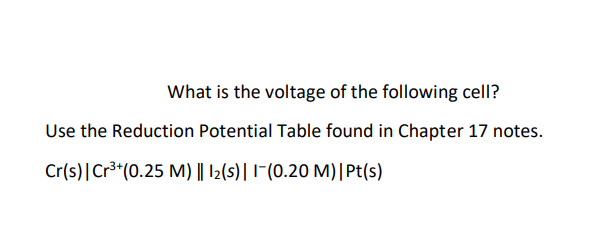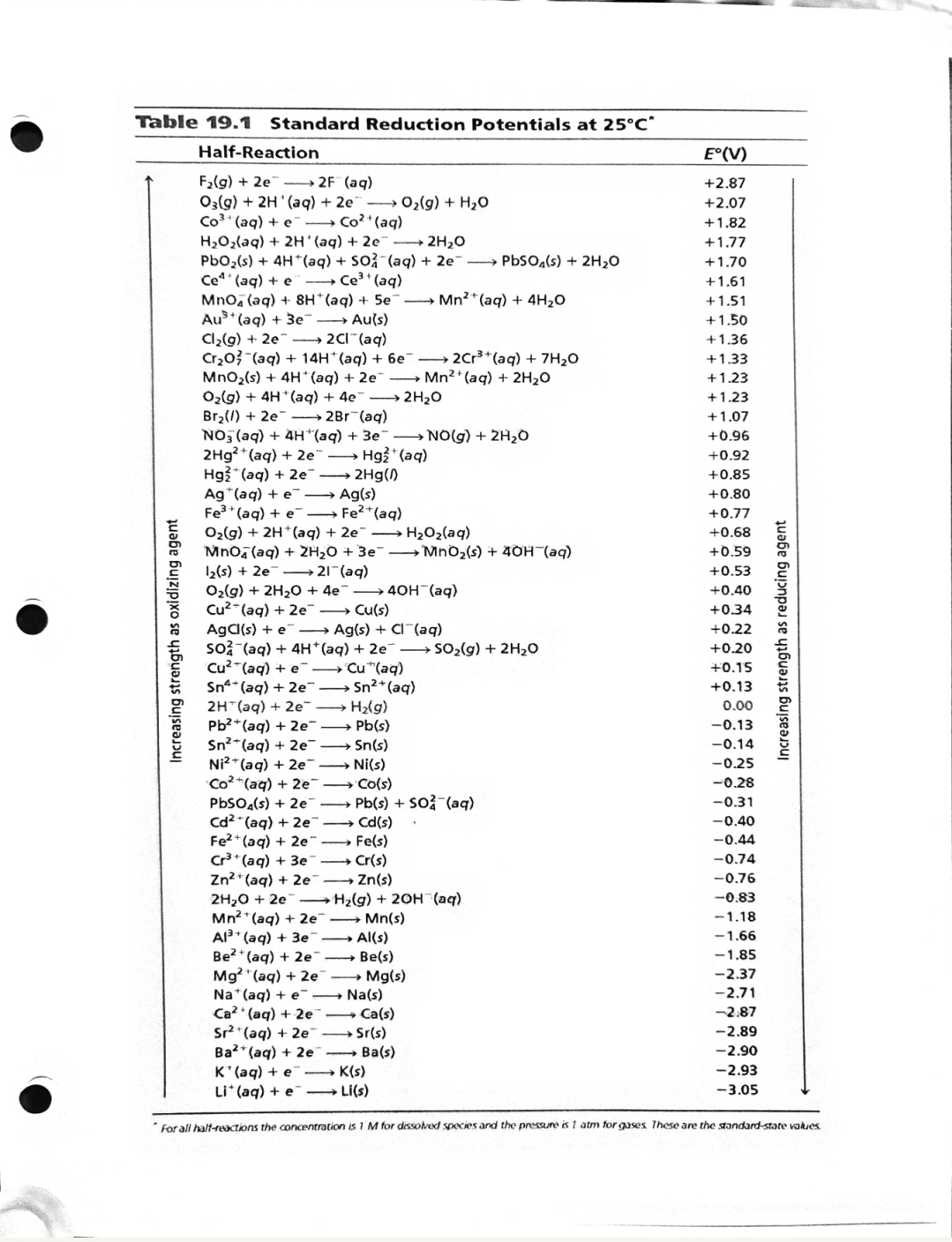What is the voltage of the following cell? Use the Reduction Potential Table found in Chapter 17 notes. Cr(s)|Cr**(0.25 M) || 12(s)| 1-(0.20 M)|Pt(s)
What is the voltage of the following cell? Use the Reduction Potential Table found in Chapter 17 notes. Cr(s)|Cr**(0.25 M) || 12(s)| 1-(0.20 M)|Pt(s)
Chemistry: Principles and Reactions
8th Edition
ISBN:9781305079373
Author:William L. Masterton, Cecile N. Hurley
Publisher:William L. Masterton, Cecile N. Hurley
Chapter17: Electrochemistry
Section: Chapter Questions
Problem 61QAP
Related questions
Question

Transcribed Image Text:What is the voltage of the following cell?
Use the Reduction Potential Table found in Chapter 17 notes.
Cr(s)|Cr³*(0.25 M) || |2(s)|1-(0.20 M)|Pt(s)

Transcribed Image Text:Table 19.1
Standard Reduction Potentials at 25°C*
Half-Reaction
E°(V)
F2(g) + 2e - 2F (aq)
O3(g) + 2H'(aq) + 2e O2(g) + H2O
Co3* (aq) + e Co?*(aq)
H2O2{aq) + 2H'(aq) + 2e¯ → 2H20
PbO2(s) + 4H*(aq) + So3 (aq) + 2e¯ → PbSO,(s) + 2H2O
Ce (aq) + e
Mno (aq) + 8H*(aq) + 5e Mn?*(aq) + 4H2O
Au (aq) + 3e → Au(s)
Cl2(9) + 2e¯
Cr20} (aq) + 14H*(aq) + 6e → 2Cr³*(aq) + 7H2O
MnO2(s) + 4H*(aq) + 2e
O29) + 4H*(aq) + 4e¯ →2H20
Br2(/) + 2e – 2B1¯(aq)
NO3 (aq) + 4H*(aq) + 3e¯ – NO(g) + 2H2O
2H9²* (aq) + 2e
Hg*(aq) + 2e
Ag*(aq) + e
Fe* (aq) + e → Fe2*(aq)
O2(g) + 2H*(aq) + 2e H2O2(aq)
MnO,(aq) + 2H20 + 3e¯ →MNO2(s) + 40H (aq)
12(s) + 2e-→ 21"(aq)
O2(g) + 2H2O + 4e → 40H¯(aq)
Cu2*(aq) + 2e
AgCl(s) + e" → Ag(s) + CI"(aq)
so3 (aq) + 4H*(aq) + 2e - SO2(g) + 2H2O
Cu2"(aq) + e¯→Cu*(aq)
Sna* (aq) + 2e
2H (aq) + 2e
Pb2*(aq) + 2e
Sn2*(aq) + 2e-
Ni2* (aq) + 2e
Co2*(aq) + 2e
PbSOa(s) + 2e™
Cd2"(aq) + 2e
Fe2* (aq) + 2e
Cr3* (aq) + 3e
Zn2* (aq) + 2e
+2.87
+2.07
+1.82
+1.77
+1.70
- Ce3* (aq)
+1.61
+1.51
+1.50
2C1"(aq)
+1.36
+1.33
→ Mn2 (aq) + 2H2O
+1.23
+1.23
+1.07
+0.96
Hg3* (aq)
→ 2Hg()
→ Ag(s)
+0.92
+0.85
+0.80
+0.77
+0.68
+0.59
+0.53
+0.40
» Cu(s)
+0.34
+0.22
+0.20
+0.15
Sn2*(aq)
H2(g)
Pb(s)
→ Sn(s)
+0.13
0.00
-0.13
-0.14
-0.25
Ni(s)
Co(s)
Pb(s) + SO3-(aq)
Cd(s)
Fe(s)
Cr(s)
→ Zn(s)
H2(g) + 20H (aq)
→ Mn(s)
Al(s)
-0.28
-0.31
-0.40
-0.44
-0.74
-0.76
--0.83
2H20 + 2e
Mn2" (aq) + 2e
Al3* (aq) + 3e
Be?* (aq) + 2e
Mg? *(aq) + 2e
Na* (aq) + e
Ca? (aq) + 2e Ca(s)
Sr2 (aq) + 2e
Ba?* (aq) + 2e Ba(s)
K'(aq) + e
Li* (aq) + e Li(s)
-1.18
-1.66
Be(s)
-1.85
-2.37
Mg(s)
Na(s)
-2.71
-2.87
→ Sr(s)
-2.89
-2.90
K(s)
-2.93
-3.05
* For all halt-reactions the concentration is 1 M for dissolved species and the pressure is 1 atm tor gases These are the standard-state vakues
Increasing strength as oxidizing agent
Increasing strength as reducing agent
Expert Solution
This question has been solved!
Explore an expertly crafted, step-by-step solution for a thorough understanding of key concepts.
Step by step
Solved in 2 steps with 2 images

Knowledge Booster
Learn more about
Need a deep-dive on the concept behind this application? Look no further. Learn more about this topic, chemistry and related others by exploring similar questions and additional content below.Recommended textbooks for you

Chemistry: Principles and Reactions
Chemistry
ISBN:
9781305079373
Author:
William L. Masterton, Cecile N. Hurley
Publisher:
Cengage Learning

Chemistry: Matter and Change
Chemistry
ISBN:
9780078746376
Author:
Dinah Zike, Laurel Dingrando, Nicholas Hainen, Cheryl Wistrom
Publisher:
Glencoe/McGraw-Hill School Pub Co

Chemistry & Chemical Reactivity
Chemistry
ISBN:
9781133949640
Author:
John C. Kotz, Paul M. Treichel, John Townsend, David Treichel
Publisher:
Cengage Learning

Chemistry: Principles and Reactions
Chemistry
ISBN:
9781305079373
Author:
William L. Masterton, Cecile N. Hurley
Publisher:
Cengage Learning

Chemistry: Matter and Change
Chemistry
ISBN:
9780078746376
Author:
Dinah Zike, Laurel Dingrando, Nicholas Hainen, Cheryl Wistrom
Publisher:
Glencoe/McGraw-Hill School Pub Co

Chemistry & Chemical Reactivity
Chemistry
ISBN:
9781133949640
Author:
John C. Kotz, Paul M. Treichel, John Townsend, David Treichel
Publisher:
Cengage Learning

Chemistry: An Atoms First Approach
Chemistry
ISBN:
9781305079243
Author:
Steven S. Zumdahl, Susan A. Zumdahl
Publisher:
Cengage Learning


Chemistry
Chemistry
ISBN:
9781305957404
Author:
Steven S. Zumdahl, Susan A. Zumdahl, Donald J. DeCoste
Publisher:
Cengage Learning